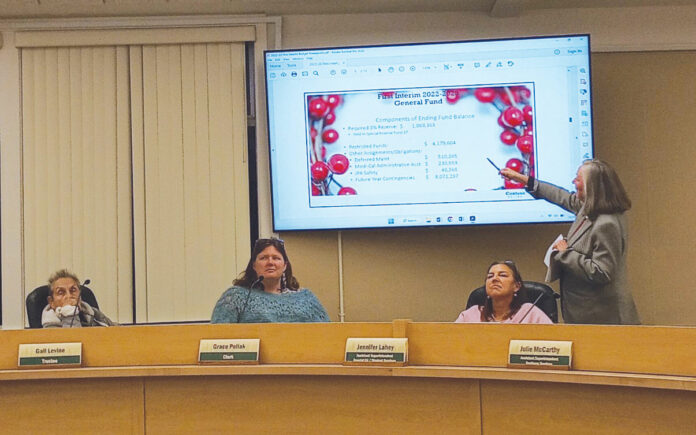
San Lorenzo Valley Unified School District used to teach just under 2,300 students a year, but that’s dropped to around 2,100.
And, unlike in such districts as Los Gatos-Saratoga, where residents pitch in directly through property taxes, SLVUSD gets government education funding based on how many students show up to class each day.
But the District hasn’t really felt the pinch quite yet, since funding rates have been calculated on a three-year rolling average, trustees heard during their regularly scheduled Dec. 14 meeting.
“We’re not alone here,” said Julie McCarthy, SLVUSD’s chief business officer, referring to how other districts are also paid-out the same way. “But, in 2022-23 things are starting to catch up to us.”
Superintendent Chris Schiermeyer explained to the Press Banner that the Local Control Funding Formula is how schools in California figure out how much money they will get from Sacramento.
The formula is broken down by grade, and extra funding is available depending on the number of free and reduced lunches are provided. It also gets additional money due to the number of homeless and English-learner students in the student body.
“Schools are only funded on Average Daily Attendance (ADA), so the students need to be present at school in order for them to be counted,” he said of the indirect monetary inflow that comes from property taxes and state aid.
Elsewhere, in areas where home and land values rise above a bar outlined by this State formula, districts fall under the “Basic Aid” category, as their funding is derived strictly from property taxes.
“Several school districts over the hill, due to the cost of housing and thus increased property taxes, are Basic Aid, and therefore receive more per student than what the LCFF formula calculates,” he said. “For example, some school districts over the hill receive $20,000-25,000 per student, due to high property taxes, while SLV receives approximately $12,000 per student.”
For districts like SLVUSD, the amount it would get from the State had been calculated on its attendance record.
“Schools were funded in the prior year or current year ADA, simply meaning that if a district had a year where they declined, they would have an additional year to assist them in mitigating that ADA loss,” Schiermeyer said. “With the start of the 2022-23 year, the governor and legislators changed the Education Code to allow for prior year, current year or three-year rolling average.”
That’s what gave SLVUSD some breathing room to recover from recent shocks to the system.
Things could have been much worse, McCarthy explained during the meeting. For SLVUSD, the SCFF ADA relief would have been around $1,893 per child had it been calculated on a yearly basis.
“Instead, we got $2,117—thank goodness,” she said, which is how the District is able to generate over $11,000 per child.
“That’s a lot,” commented Gail Levine, who was officially reinstalled on the board earlier in the meeting.
Over 900 houses burned in the county during the CZU Lightning Complex fire, and most have been unable to rebuild; meanwhile, the pandemic caused families to reconsider how they wanted to school their children.
But, Schiermeyer noted, SLVUSD’s enrollment appears to have stabilized.
“We’re not losing kids now,” he told trustees. “Covid ‘held us harmless,’ and we have a three-year rolling average.”
He said there’s no need to worry about a funding decline, since it’s been accounted for in the financial planning process.
SLVUSD plans $27.7 million in expenditures in 2022-23, while leaving $4.2 million in reserves. It expects to spend that down to $1.8 million in 2024-25.
During that period, payments from the Unrestricted Budget will rise to $28.9 million in 2023-24, then $29.3 million in 2024-25.
McCarthy showed trustees a bar graph depicting money coming in and going out over recent years.
“This is when we start getting Covid funding—look at all that,” she pointed out. “And then look at the expenses going way up—that’s because we’re spending the Covid funding a lot more.”
SLVUSD’s charter school doesn’t get to use the rolling average ADA.
“Right now, their enrollment is 297, which is a little lower than we thought,” she said, noting attendance rates there have dropped from 99% to around 96% at the charter, “like a normal school.”
Restricted expenses increased $1,760,132, in 2021-22, as the District spent $95,000 more on salaries and benefits, $1.04 million more on books and supplies, $618,000 more on services, but spent $12,000 less on its Capital Outlay.
This was possible because restricted revenue increased $3,267,698 in 2021-22, with half-a-million-dollars extra coming in to its federal revenue pot and $2.66 million in additional State revenue in $108,000—it also had a $108,000 increase from local revenue sources to the General Fund.
The District is planning to spend $510,295 on deferred maintenance and more than $200,000 to cover Medi-Cal administrative costs.
McCarthy added SLVUSD aced a recent audit.
“All funds will end with a positive fund balance, and all funds will have a positive cash flow,” she said. “Looking ahead, we’re going to continue to monitor our expenses, because things are constantly changing.”
All of this leaves Schiermeyer pretty happy with how the ledgers are sitting right now.
“As part of our budget process, we look at enrollment trends, therefore, we anticipated a loss of student enrollment back in 2018-19 and 2019-20 with our enrollment now stabilizing around 2,100 students (TK-12),” he said. “Due to analyzing this data, we adjusted our budget accordingly.”
He pledges to use School Services of California data, as well as SLVUSD’s own forecasting models, to move forward with a conservative approach to school budgeting into the New Year.
“SLVUSD has always had a positive certification with the State,” he said. “We continue to maintain a healthy budget.”
The board voted to approve the 2022-23 First Interim Financial Report unanimously.












